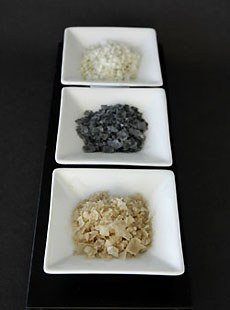SALT & SEASONINGS: Cutting Down On Sodium In 2010
| Americans eat way too much salt. Our processed foods and recipes are packed with much more than is good for you (the same for sugar). Only 11% of the sodium in our diets comes from our own saltshakers; nearly 80% is added to foods before they are sold.
The National Salt Reduction Initiative will be seeking to have us reduce salt intake by 20%. Too much sodium in your diet can increase blood pressure, which can lead to stroke and heart disease. Even if you’re 20 years old and not thinking about stoke and heart disease, the bad eating habits you develop now are the ones you’ll have to struggle to give up in another 20 years. g. As I’m sure you know,. This can also be of interest for February’s Heart Health Month. Mrs. Dash Seasoning Blend, an all-natural blend of 14 natural herbs and spices that has been a lifesaver to people who need to cut down on salt but still want flavor (also available as sodium-free grilling spices and marinades), offers these tips for reducing sodium intake: To Cut Down On Salt |

Sea salts have lovely flavor, but they have |
|
| 1. Choose fresh, unprocessed or fresh, frozen foods. Prepared foods are loaded with salt. 2. Read food labels for sodium content. 3. Choose foods with less than 200mg of sodium per serving. That’s not going to be easy! 4. Consume pre-prepared foods that are “low in sodium” or “no added sodium.” 5. Limit processed foods such as canned or dried soups, canned vegetables, frozen dinners, “instant” foods and flavored rice/pasta packages. 6. Use less sodium at the table and in cooking. 7. Use no-sodium or low-sodium seasonings. 8. Flavor food with lemon juice, fresh garlic, spices, herbs and flavored vinegar. 9. Use only small amounts of condiments, like pickles, sauces, olives, etc. 10. Ask for less salt or sodium to be added to your food when eating in restaurants. Chefs tend to throw salt on proteins before plating them.
How much salt should you consume a day? According to the Mayo Clinic, healthy younger adults should keep sodium consumption between 1,500 and 2,300 mg of sodium a day (only a few hundred mg/day are actually needed to maintain healthy body function). People with high blood pressure and anyone middle-aged or older should aim for the low end of the range. Is sea salt better than table salt? It has the same amount of sodium as table salt, but is pure (no chemicals are used in the refining) and has better flavor and texture.
|
||


